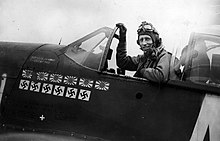The examples and perspective in this United States may not represent a worldwide view of the subject. (March 2024) |
A victory marking (also called a victory mark, kill marking, or kill mark, or mission symbol) is a symbol applied in stencil or decal to the side of a military aircraft to denote an aerial victory achieved by the aircraft's pilot or crew. The use of victory markings originated during World War I, burgeoned during World War II and frequently took the form of the roundel or national flag of the nationality of the aircraft defeated.[1]

In 2012, a German Eurofighter was spotted with a kill mark denoting a simulated victory over a U.S. Air Force F-22 Raptor, achieved in a dogfight during a training exercise.[2]
In the United States Air Force, as of 2010, victory markings are applied in the form of six inch green stars set within a black border with the type of aircraft defeated stencilled inside the star in white lettering.[3]
Mission symbol
editVictory marks have been applied to aircraft for reasons other than aerial victories. During the period of its use for astronaut recovery, the U.S. Navy's Helicopter 66 bore victory marks showing a space capsule silhouette, with one mark added for each recovery in which it participated.[4]
Gallery
edit-
Boeing B-17 Flying Fortress Memphis Belle with victory markings signifying 25 bombing missions and 8 fighter kills.
-
Nose section of Martin B-26 Marauder Flak-Bait (serial no. 41-31773), showing the large number of victory marks from its 207 missions over Europe during World War II.
-
An F-16BM (serial no. 84606) from the No. 11 Squadron 'Arrows' of the Pakistan Air Force with an Indian flag on its nose as a kill mark signifying its shoot down of an Indian Air Force MiG-21 during Operation Swift Retort in 2019.
-
McDonnell Douglas F-15 Eagle of the Israeli Air Force showing 4 kill marks for aerial victories over Syrian pilots in the 1982 Lebanon War.
-
F-16A Netz 107 of the Israeli Air Force. Netz 107 has an unmatched combat record in the IDF: it destroyed the Iraqi Osirak nuclear reactor as part of Operation Opera in 1981, and was credited with 6.5 enemy aircraft kills in 1982 (one was a joint interception with another Israeli fighter).
-
IAF McDonnell Douglas F-15D Yad Ha Nefetz (Shatterhand) with Operation Wooden Leg success marking
-
An U.S. Air Force McDonnell Douglas F-4 Phantom II pictured at Tinker Air Force Base. On its intake splitter-plate is a kill mark in the form of a red star, signifying an aerial victory achieved during the Vietnam War.
-
A Pakistan Air Force demo team JF-17 Thunder with an Iranian drone kill mark on the nose which it shot down in 2017.
See also
editReferences
edit- ^ Herman, Bruce (16 February 2005). "Painted Warbirds". PBS. Retrieved 11 May 2018.
- ^ Cenciotti, David (23 July 2012). "F-22 Raptor kill markings shown off by German Eurofighter Typhoons". The Aviationist. Retrieved 11 May 2018.
- ^ "Air Combat Command 21-105". AF.mil. United States Air Force. Retrieved 31 August 2021.[dead link]
- ^ "Helicopter Unit Changes Command". Chula Vista Star-News. newspapers.com. 26 September 1971. p. 20. Retrieved 7 February 2018.
Further reading
edit- Apple, Carolyn (3 September 2015). "World War II Mission Symbols". Division of Historical and Cultural Affairs. State of Delaware. Retrieved 30 July 2019.
External links
editMedia related to Aircraft success markings at Wikimedia Commons